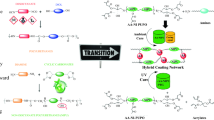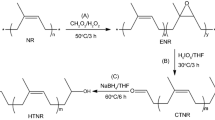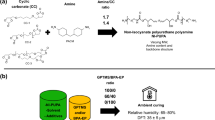Abstract
High performance, high solid and low in volatile organic content (VOC) multifunctional coatings have wide applications in protection and decoration of materials. This work describes the synthesis of novel hyperbranched polymer (HBP) based polyurethanes (PUs) that exhibit antimicrobial property and are environmentally benign. Nitrogen rich HBP having nitrogen atom as a core was synthesized by A3 + B3 polycondensation in two step reaction. In the first step, monomer A3, a tricarboxylic acid, was synthesized by triethanolamine (B3, the core) with succinic anhydride, while in the second step, monomers A3 and B3 were used to synthesize hyperbranched polyester polyol by polycondensation reaction. The HBP thus formed was reacted with 4,4′-methylenedicyclohexyl diisocyanate (H12 MDI) in varying ratios of NCO to OH to form NCO- terminated PU prepolymers in a self-catalyzed reaction. The prepolymers were then coated onto mild steel panels as well as tin foils and stored at ambient conditions for 20 days to evaluate the moisture-cured PU-urea film properties. The formation of tribasic acid (A3), HBP and PU was confirmed by 1H NMR, 13C NMR, FTIR and ESI-mass spectroscopy. Thermal, mechanical, anti-corrosive and antimicrobial studies as well as the effect of varying NCO to OH ratio on these properties were investigated. The properties of PU-urea were found to be suitable for corrosion protection as well as biomedical and various other applications.
















Similar content being viewed by others
References
Jena KK, Raju KVSN, Prathab B, Aminabhavi TM (2007) Hyperbranched polyesters: synthesis, characterization, and molecular simulations. J Phys Chem B 111:8801–8811
Kim YH (1998) Hyperbranched polymers 10 years after. J Polym Sci Part A: Polym Chem 36:1685–1698
Malmstrom E, Hult A (1997) Dendritic molecules. J Macromol Sci Rev Macromol Chem Phys C 37:555–579
Frechet JMJ (1994) Functional polymers and dendrimers: reactivity, molecular architecture, and interfacial energy. Science 263:1710–1715
Jikei M, Kakimoto M (2001) Hyperbranched polymers: a promising new class of materials. Prog Polym Sci 26:1233–1285
Yang D, Chen Z, Rong X, Zhang H, Qiu F (2014) Formulation and characterization of epoxidized hydroxyl-terminated hyperbranched polyester and its application in waterborne epoxy resin. J Polym Res 21:331–338
Fradet A, Tessier M (2007) First shell substitution effects in hyperbranched polymers: kinetic-recursive probability analysis. Macromolecules 40:7378–7792
Liu QC, Zhao P, Chen YM (2007) Divergent synthesis of dendrimer-like macromolecules through a combination of atom transfer radical polymerization and click reaction. J Polym Sci Part A: Polym Chem 45:3330–3341
Reisch A, Komber H, Voit B (2007) Kinetic analysis of two hyperbranched A2 + B3 polycondensation reactions by NMR spectroscopy. Macromolecules 40:6846–6858
Hecht S, Emrich TS, Frechet JMJ (2000) Hyperbranched porphyrins-a rapid synthetic approach to multiporphyrin macromolecules. Chem Commun 21:313–314
Kudo H, Maruyama K, Shindo S, Nishikubo T, Nishimura I (2006) Syntheses and properties of hyperbranched polybenzoxazole by thermal cyclodehydration of hyperbranched poly [o-(t-butoxycarbonyl) amide] via A2 + B3 approach. J Polym Sci Part A: Polym Chem 44:3640–3649
Russo S, Boulares A, Mariani A (1998) Synthesis of hyperbranched aromatic polyamides by direct polycondensation. Macromol Symp 128:13–20
Stumbe J-F, Bruchmann B (2004) Hyperbranched polyesters based on adipic acid and glycerol. Macromol Rapid Commun 25:921–924
Chattopadhyay DK, Raju KVSN (2007) Structural engineering of polyurethane coatings for high performance applications. Prog Polym Sci 32:352–418
Revie RW, Uhlig HH (2004) Corrosion and corrosion control, 4th edn. Wiley, New Jersey
Madkour TM, Azzam RA (2002) Use of blowing catalysts for integral skin polyurethane applications in a controlled molecular architectural environment: synthesis and impact on ultimate physical properties. J Polym Sci Part A: Polym Chem 40:2526–2536
Su T, Wang GY, Wang SL, Hu CP (2010) Fluorinated siloxane-containing waterborne polyurethaneureas with excellent hemocompatibility, waterproof and mechanical properties. Eur Polym J 46:472–483
Lamba NMK, Woodhouse KA, Cooper SL (1997) Polyurethanes in biomedical applications, 1st edn. CRC Press, Florida
Siyanbola TO, Sasidhar K, Anjaneyulu B, Kumar KP, Rao BVSK, Narayan R, Olaofe O, Akintayo ET, Raju KVSN (2013) Anti-microbial and anti-corrosive poly (ester amide urethane) siloxane modified ZnO hybrid coatings from thevetia peruviana seed oil. J Mater Sci 48:8215–8227
Alam J, Riaz U, Ahmad S (2008) Development of nanostructured polyaniline dispersed smart anticorrosive composite coatings. Polym Adv Technol 19:882–888
Mishra AK, Narayan R, Raju KVSN, Aminabhavi TM (2012) Hyperbranched polyurethane (HBPU)-urea and HBPU-imide coatings: effect of chain extender and NCO/OH ratio on their properties. Prog Org Coat 74:134–141
Huybrechts J, Dusek K (1998) Star oligomers for low VOC polyurethane coatings. Surf Coat Int 3:117–127
Belote SN, Blount WN (1981) Optimizing resins for low VOC. J Coat Technol 53:33–37
Voit B (2000) New developments in hyperbranched polymers. J Polym Sci Part A: Polym Chem 38:2505–2525
Bassner SL (1997) Ultra low VOC Polyurethanes coatings. US Patent 5670599
Nunez CM, Ramsey GH, Barfield PM, Jones LG, Andrady AL (2010) Reduced VOC coatings using chemically modified hyperbranched polymers. US Patent 7851539 B2
Mishra RS, Khanna AS (2011) Formulation and performance evaluation of hydroxyl terminated hyperbranched polyesters based poly (ester–urethane–urea) coatings on mild steel. Prog Org Coat 72:769–777
Kenawy EI-R, Worley SD, Broughton R (2007) The chemistry and applications of antimicrobial polymers: a state-of-the-art review. Biomacromolecules 8:1359–1384
Paleari AG, Marra J, Pero AC, Rodriguez LS, Ruvolo-Filho A, Compagnoni MA (2011) Effect of incorporation of 2-tert-butylaminoethyl methacrylate on flexural strength of a denture base acrylic resin. J Appl Oral Sci 19:195–199
Goswami A, Singh AK (2004) Hyperbranched polyester having nitrogen core: synthesis and applications as metal ion extractant. React Funct Polym 61:255–263
Clausnitzer C, Voit B, Comber H, Voigt D (2003) Poly (ether amide) dendrimers via nucleophilic ring opening addition reactions of phenol groups toward oxazolines: synthesis and characterization. Macromolecules 36:7065–7074
Bhardwaj R, Mohanty AK (2007) Modification of brittle polylactide by novel hyperbranched polymer-based nanostructures. Biomacromolecules 8:2476–2484
Jena KK, Chattopadhyay DK, Raju KVSN (2007) Synthesis and characterization of hyperbranched polyurethane-urea coatings. Eur Polym J 43:1825–1837
Spindler R, Frechet JMJ (1993) Synthesis and characterization of hyperbranched polyurethanes prepared from blocked isocyanate monomers by step-growth polymerization. Macromolecules 26:4809–4813
Dhevi DM, Prabhu AA, Kim H, Pathak M (2014) Studies on the toughening of epoxy resin modified with varying hyperbranched polyester-toluene diisocyanate content. J Polym Res 21:503–511
Segawa Y, Higashihara T, Ueda M (2010) Hyperbranched polymers with controlled degree of branching from 0 to 100%. J Am Chem Soc 132:11000–11001
Holtel D, Burgath A, Frey H (1997) Degree of branching in hyperbranched polymers. Acta Polym 48:30–35
Gupta T, Adhikari B (2003) Thermal degradation and stability of HTBP-based polyurethane and polyurethane-ureas. Thermochim Acta 402:169–181
Chattopadhyay DK, Sreedhar B, Raju KVSN (2006) Influence of varying hard segments on the properties of chemically crosslinked moisture-cured polyurethane-urea. J Polym Sci Part B: Polym Phys 44:102–118
Li P, Shen Y, Yang X, Li G (2012) Preparation and properties of waterborne cationic fluorinated polyurethane. J Polym Res 19:9786–9795
Wang FC, Feve M, Lam TM, Pascault J-P (1994) FTIR analysis of hydrogen bonding in amorphous linear aromatic polyurethanes. I. Influence of temperature. J Polym Sci Part B: Polym Phys 32:1305–1313
Waterlot V, Couturier D, Waterlot C (2011) Structure and physical properties in crosslinked polyurethanes. J Appl Polym Sci 119:1742–1751
Ning L, Wang D-N, Ying S-K (1997) Hydrogen bonding properties of segmented polyether poly (urethane urea) copolymer. Macromolecules 30:4405–4409
Ren Z, Ma D, Yang X (2003) H-bond and conformations of donors and acceptors in model polyether based polyurethanes. Polymer 44:6419–6425
Mishra AK, Chattopadhyay DK, Sreedhar B, Raju KVSN (2006) FT-IR and XPS studies of polyurethane-urea-imide coatings. Prog Org Coat 55:231–243
Alam M, Ashraf SM, Ahmad S (2008) Pyridine-poly (urethane ester amide) coatings from linseed oil. J Polym Res 15:343–350
Trovati G, Sanches EA, Neto SC, Mascarenhas YP, Chierice GO (2010) Characterization of polyurethane resins by FTIR, TGA and XRD. J Appl Polym Sci 115:263–268
Kontou E, Spathis G, Niaounakis M, Kefalas V (1990) Physical and chemical cross-linking effects in polyurethane elastomer. Colloid Polym Sci 268:636–644
Wang L, Shen Y, Lai X, Li Z, Liu M (2011) Synthesis and properties of crosslinked waterborne polyurethane. J Polym Res 18:469–476
Prisacariu, C (2011) Polyurethane Elastomers: From morphology to mechanical aspects, first edn. Springer
Chen S, Wang Q, Wang T (2012) Preparation, tensile, damping and thermal properties of polyurethane based on various structural polymer polyols: effect of composition and isocyanate index. J Polym Res 19:9994–10000
Wang H-H, Lin M-S (1998) Biocidal polyurethane and its antibacterial properties. J Polym Res 5:177–186
Kantheti S, Sarath PS, Narayan R, Raju KVSN (2013) Synthesis and characterization of triazole rich polyether polyols using click chemistry for polyurethanes. React Funct Polym 73:1597–1605
Ikeda T, Tazuke S (1984) Biologically active polycations: synthesis and antimicrobial activity of poly(trialkylvinylbenzylammonium chloride)s. Makromol Chem 185:869–876
Chen CZ, Beck-Tan NC, Dhurjati P, Van Dyk TK, LaRossa RA, Cooper SL (2000) Quaternary ammonium functionalized poly (propylene imine) dendrimers as effective antimicrobials: structure-activity studies. Biomacromolecules 1:473–480
Acknowledgments
The present research work was supported by CSIR, India under Intel-Coat Project (CSC-0114). RK thank to CSIR-IICT, Hyderabad and NIT, Durgapur, for providing necessary facilities to carry out this work and the Ministry of HRD and Department of Science & Technology, Govt of India for financial assistance.
Author information
Authors and Affiliations
Corresponding author
Electronic supplementary material
Below is the link to the electronic supplementary material.
ESM 1
(PDF 59.7 kb)
Rights and permissions
About this article
Cite this article
Kumar, R., Narayan, R., Aminabhavi, T.M. et al. Nitrogen rich hyperbranched polyol via A3 + B3 polycondensation: thermal, mechanical, anti-corrosive and antimicrobial properties of poly (urethane-urea). J Polym Res 21, 547 (2014). https://doi.org/10.1007/s10965-014-0547-8
Received:
Accepted:
Published:
DOI: https://doi.org/10.1007/s10965-014-0547-8




